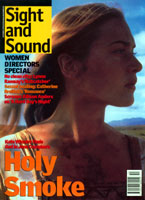Primary navigation

South Africa/UK 1998
Reviewed by Mike Higgins
Our synopses give away the plot in full, including surprise twists.
Following an attempt to fly from the roof of a London bank, depressed artist Richard is sentenced to be a companion to the wheelchair-bound Jane, who has a motor neurone disease. After a rocky start, the two hit it off. Richard shuns his ex-girlfriend Julie.
At his farm, Richard shows Jane the bi-plane he's building, whereupon she asks him to find a gigolo who will take her virginity. Richard reluctantly agrees to take Jane to London to fulfil her wish. Richard then shocks Jane by planning to rob a bank to pay for the gigolo. She asks Richard whether he will have sex with her; he refuses. The gigolo arrives for Jane; Richard sets off to rob the bank where, it turns out, Julie works. Neither Jane nor Richard go through with it. Julie confronts Richard who passes Jane off as his girlfriend. Richard and Jane fly his plane and have sex. Months later, just before her death, Jane is best man at Richard and Julie's wedding.
The goodwill extended towards Kenneth Branagh ran out about the same time as this former golden boy of British cinema started casting his spouses opposite him. It ought then to have been with trepidation that he and present partner Helena Bonham Carter took on this whimsical odd-couple comedy. What's more, Bonham Carter appears spectacularly against type as a motor-neurone-disease sufferer, a role all the more conspicuous given the warmly received performances of disabled actors Rosemarie Stevenson in Orphans and Heather Rose in Dance Me to My Song.
Were it not for the fact that Bonham Carter has striven since Getting It Right to broaden the repertoire of Merchant-Ivory roles that established her, her turn might be dismissed an Oscar-chasing aberration. Mastering a halting speech pattern and awkward wheelchair-bound posture, her performance is a feat of actorly technique - impressive if a little flashy. The source of this reductive portrait is not Bonham Carter alone, however.
From Coming Home to Crash, mainstream film has never quite got to grips with disabled sexuality, betraying an uneasiness which screenwriter Richard Hawkins perpetuates. Whether it's the internet porn Jane consumes forlornly or the electronic speaking device she uses to voice her innermost desires to Richard, these hardware-bound scenes fail to throw any light on Jane's frustrated libido. The script also labours to strike an attitude of easy-going irreverence towards a sensitive subject: "As cripples go, you're really quite fanciable," jokes Richard.
The taint of expediency marks Jane's characterisation. So as not to complicate Richard's reunion with his old girlfriend Julie, Jane conveniently declares that even if sex with Richard is within her reach, she's resigned to the conclusion that a loving relationship is not. Her encounter with the gigolo - she lies frozen with fear throughout - illustrates succinctly whose story Hawkins is more concerned with. Director Paul Greengrass (Resurrected) seems far more interested in the character of Richard. The shots of the construction and flight of his plane essay a gentle lyricism which the film denies Jane in depicting her pursuit of sex. Whereas The Theory of Flight apologises for Jane's desire, it gives its blessing to Branagh's rumpled malcontent. The analogy between flying and sex isn't just clichéd, it's in bad faith as their equivalence has no echo in the way the film subordinates Jane's neurosis to Richard's.
The character of Richard himself remains infuriatingly vague. Why, for instance, does flying in particular obsess him? With only an improbably patient girlfriend and an understanding judiciary to compare him with, Richard's plight looks more like listless self-pity than troubled alienation. This said, one shot alone, almost Loachian in its muted humanism, suggests that Greengrass had it within him to introduce a subtler shade to the otherwise schematic central relationship. Their initial trip to a park having ended in mutual dislike, Jane and Richard are seen watching a kite over the brow of a hill. It swoops up and dives down out of sight, intimating a vaulting delicacy in their friendship which the film sadly chooses not to pursue.